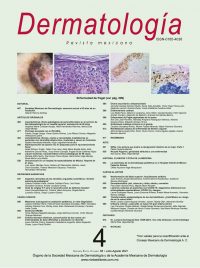Clinical characteristics, costs, and unmet needs in patients with mild, moderate, and severe atopic dermatitis.
Dermatol Rev Mex. 2021; 65 (4): 494-507. https://doi.org/10.24245/dermatolrevmex.v65i4.6599
Natalia Hernández-Mantilla,1 Hugo Laignelet-Hernández2
1 Dermatóloga, MSc farmacoeconomía.
2 Gastroenterólogo pediatra, MSc farmacoeconomía.
Resumen
OBJETIVOS: Describir las características fenotípicas, el efecto emocional y los costos directos e indirectos reportados por los pacientes con dermatitis atópica, todo de acuerdo con la severidad, al igual que evaluar el grado de satisfacción con su tratamiento actual.
MATERIALES Y MÉTODOS: Estudio descriptivo transversal en el que se aplicó una encuesta a 138 pacientes mayores de 7 años con dermatitis atópica. Se registraron datos demográficos, comorbilidades, fenotipo, tratamientos recibidos y satisfacción, así como costos de bolsillo e indirectos.
RESULTADOS: Se incluyeron 114 pacientes mayores de 18 años y 24 menores. El 68.8% era del sexo femenino. La manifestación más frecuente en todas las edades fue en los pliegues (71%), numular (10%) y el tipo prurigo (20%) en niños. Se encontraron comorbilidades personales atópicas y familiares en el 80%. Se confirmó un importante efecto en la calidad de vida, especialmente en la dermatitis atópica moderada y severa; el 60% de los pacientes tenía afectación del sueño; el 31.2 y el 18.1% referían ansiedad y depresión, respectivamente; igualmente, la mayor severidad se relacionó con mayor insatisfacción con su tratamiento.
CONCLUSIONES: Este estudio muestra distribución fenotípica y efecto de la enfermedad en niños y adultos con diferentes grados de severidad de la dermatitis, junto a los altos costos que acarrea. La satisfacción global con el tratamiento fue sólo del 40%, campo que debemos seguir explorando.
PALABRAS CLAVE: Dermatitis atópica; calidad de vida; ansiedad; depresión.
Abstract
OBJECTIVE: To describe the phenotypic characteristics, the emotional effect, and the direct and indirect costs reported by patients with atopic dermatitis, all according to severity, as well as evaluating the degree of satisfaction with their current treatment.
MATERIALS AND METHODS: Survey type study applied to 138 patients older than 7 years with atopic dermatitis. Demographic data, comorbidities, phenotype, treatments received and their satisfaction, out-of-pocket and indirect costs were recorded.
RESULTS: Twenty-four minors and 114 adults were included, 68.8% were women. The most frequent localization was in folds, but 10% of patients had nummular presentation and prurigo type (20%) in children. Atopic comorbidities were found in 73% of patients and 80% of their families. The impact in quality of life was associated with moderate to severe disease; 60% of the patients had sleep disturbances, 31.2% and 18.1% referred anxiety and depression, respectively. Severity disease was associated with more dissatisfaction to the treatment.
CONCLUSIONS: This study showed phenotypic distribution and highlighted the burden of atopic dermatitis in children and adults related with different severity of the disease. The global satisfaction with the treatment accounted for only 40%, this is an important gap in atopic dermatitis study.
KEYWORDS: Atopic dermatitis; Quality of life; Anxiety, Depression.
Recibido: febrero 2021
Aceptado: febrero 2021
Este artículo debe citarse como: Hernández-Mantilla N, Laignelet-Hernández H. Características clínicas, costos y necesidades insatisfechas en pacientes con dermatitis atópica leve, moderada y severa en Colombia. Dermatol Rev Mex 2021; 65 (4): 494-507.

